 |
Picks is a monthly sampling of Japan's art scene, offering short reviews of exhibitions at museums and galleries in recent weeks, with an emphasis on contemporary art by young artists. |
 |
 |
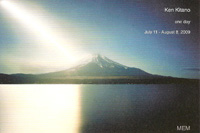 |
|
| Ken Kitano: "one day" |
| 11 July - 8 August 2009 |
MEM
(Osaka) |
 |
| Kitano photographed the landscapes in his "one day" series by exposing the film for an entire day, from sunrise to sunset. In his photo of Mt. Fuji the sun describes an arc of light that plunges into the mountain, while the crowds of people hurrying through his cityscapes disappear almost entirely, leaving behind only surreal traces of themselves. Rather than excising instants of time, Kitano allows it to accumulate, creating a mystical space in the process. |
|
|
 |
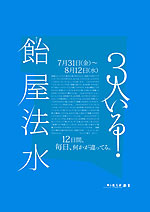 |
|
| Norimizu Ameya: Sannin Iru! (Three People Here!) |
| 31 July - 12 August 2009 |
Little more
(Tokyo) |
 |
| Someone else who claims to be the protagonist appears in the room. Then a third person appears making the same claim. The plot thickens. It's a simple premise, but we never find out why there are two, or even three, selves. Billed as a theater performance that is simultaneously an art exhibit, an installation, even a musical event, Ameya's staging of Junnosuke Tada's play, with its meta-drama and meta-roles, seems to be devised for the purpose of playing with the essentials of theater. |
|
|
|
|
|
|
 |
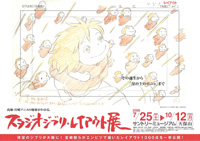 |
|
Studio Ghibli Layout Designs |
| 25 July - 12 October 2009 |
Suntory Museum
(Osaka)
|
 |
This show finally opened in Osaka a year after making a huge splash at the Museum of Contemporary Art in Tokyo. Once again one is impressed above all by the vast number of pictures that must be drawn to provide the layouts (the original sketches comprising the blueprint) for a single animation film. Creator of Hayao Miyazaki's masterpieces, Studio Ghibli here displays some 1,300 layouts from those productions. The proof of animation genius, it would appear, is found not so much in artistic quality as in sheer quantity.
|
|
|
|
|
|
|
|
 |
|
| Nyokyu Makishima: Place for God and Buddha |
| 25 July - 23 August 2009 |
Mitaka City Gallery of Art
(Tokyo) |
 |
| This thorough retrospective of the idiosyncratic religious painter Nyokyu Makishima (1892-1975) demonstrates the extent to which he blended Eastern and Western art techniques (he used both oils and sumi ink) as well as Christian and Buddhist imagery. Makishima studied iconography at an Orthodox Christian seminary in Tokyo, but eventually came to view God and Buddha as one, and in many of his works both deities coexist in the same frame. Though his sumi brushwork is not much to write home about, his touch with oil is downright seductive. |
|
|
 |
|
 |

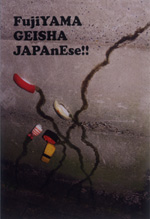 |
|
Chim Pom: FujiYAMA, GEISHA, JAPAnEse!! |
| 26 July - 8 August 2009 |
Mujin-to Production
(Tokyo) |
 |
|
The notoriously irreverent art unit Chim Pom here tackles the theme of Japanese stereotypes seen through the eyes of foreigners. Unfortunately the installation packs little punch overall, provoking neither thought nor laughter. Its sole saving grace is that, when you poke your head out the gallery window, you see team member Mizuno perched in full Ninja regalia, striking a valiant pose atop a building on the other side of the Chuo Line tracks. Otherwise, however, there is nothing to goose the preconceptions or the funny bone of the audience, whether Japanese or foreign.
|
|
 |
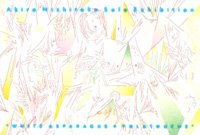 |
Akira Nishitake: White Asparagus and Polatouche
|
| 31 July - 12 August 2009 |
AD&A Gallery
(Osaka) |
 |
|
Nishitake has festooned the gallery walls with scads of pen and ink drawings featuring goblin-like characters and, occasionally, repetitions of abstract patterns. The beauty of his lines is more than enough to draw the viewer in. The computer-manipulated drawings in the second-floor gallery, on the other hand, still appear to be in the experimental stage.
|
|
|
|
|
|
|
|
|
|
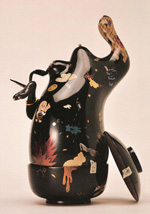 |
Satoshi Someya: OKEMONO
|
| 4 August - 5 September 2009 |
imura art gallery
(Kyoto) |
 |
|
Arms, legs and a torso protrude from a lacquer bowl . . . objects of this sort make up most of Someya's oeuvre. The medium is lacquer and the techniques are traditional ones like maki-e (lacquer sprinkled with gold or silver powder) and raden (lacquer inlaid with shell), but the motifs are a crazy quilt of manga-like characters, bizarre creatures, random Kanji, and other odds and ends. Someya's work exudes an odor of kitsch, but his blend of traditional technique with a contemporary sensibility makes it unique.
|
|
|
|
 |
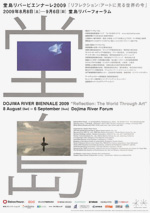 |
|
Dojima River Biennale 2009 - "Reflection: The World through Art" |
| 8 August - 6 September 2009 |
Dojima River Forum
(Osaka) |
 |
|
Mori Art Museum director Fumio Nanjo served as artistic director of the 2006 and 2008 Singapore Biennale, from which he has selected 26 works for this biennale by the Dojima River in downtown Osaka. All carry some sort of political or social message, and the dominant medium is film, exemplified by Ecuadoran Tomas Ochoa's take on the collision between Christianity and Islam, and Palestinian Suha Shoman's fierce critique of the Palestine problem. The high quality of the works shown is accentuated by the excellent sound and lighting of the venue.
|
|
|
|
|
 |
|
 |
|